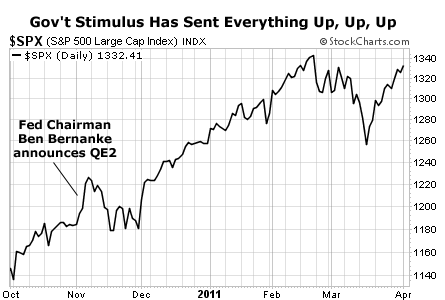 Yesterday, I told you the government’s huge, $600 billion stimulus program is scheduled to end on June 30 – 76 days from today.
Yesterday, I told you the government’s huge, $600 billion stimulus program is scheduled to end on June 30 – 76 days from today.
That day is so important for investors, one major fund manager, Bill Gross, is calling it “D-Day.”
Investors need to watch this date carefully. As you read yesterday, the government can move markets, no question. If you’re not convinced, here’s another look at it:

This chart shows the S&P 500 since QE2 began. Even though the market had already rebounded 80% from its March 2009 bottom, it’s up another 10% since QE2 was announced.
QE2 is stock market Viagra. And you know what happens when that stuff wears off.
[ad#Google Adsense]Commodity prices are up as well, with the CRB index of 19 commodities up 18% since QE2 began. Crude oil was under $85 a barrel before QE2. Now it’s over $107 per barrel… a 27% rise. Copper was about $3.90 per pound. Now, it’s $4.30… up 12%. Up, up, up. Financial Viagra is performing as advertised.
As I showed you yesterday, markets peak during a stimulus program and then fall or go sideways once the stimulus spending dries up… which is what I expect to happen again. So here’s what you do…
A weak stock market, of course, is a value investor’s dream, because weak stock markets create bargains. So the first thing you should do to prepare for the expiration of QE2 is to have plenty of cash handy.
How much is plenty? It’s a matter of style, but to me, plenty of cash in an equity account starts around 35%-40%. That’ll give you enough to take a large stake in bargains that crop up during a period of market weakness following QE2. That’s Step 1: Hold plenty of cash.
Step two is a familiar refrain to my readers. We’re talking about money-printing, inflation, and currency devaluation. The value of our currency is at risk. You should own some gold and silver coins. I buy Krugerrands, the most widely circulated gold bullion coin in the world. I also buy one-ounce silver rounds. That’s Step 2: Buy gold and silver bullion.
Step three is more aggressive, and therefore not for everyone: Sell short weak stocks. Speculative assets have performed better during QE2 than safer, less speculative assets. They’ll likely suffer worse in the aftermath. That’s Step 3: Sell short weak stocks.
Step four is familiar to DailyWealth readers. The first stocks you should buy are World Dominators. These are the safest stocks in the world. Lately, they’ve been selling at their cheapest prices in almost two decades. When these stocks are this cheap, you want to buy them. And if they happen to get cheaper, you want to buy even more. That’s Step 4: Build a core position in World Dominators.
The best part is, no matter what happens on June 30, this advice ought to protect your money and make you a profit.
The ultimate hedge is one that still provides a good outcome, even if the hedged event doesn’t happen. Whether I’m right or wrong about June 30, it’s still a good idea to hold plenty of cash, own plenty of gold and silver, sell short weak stocks, and build a core position in World Dominator stocks. June 30 can come and go without a ripple in the market, and my advice will still apply.
Cash is the most liquid way to hold your money. Gold and silver bullion will still be a “real money” hedge against government perfidy. Truly weak stocks will falter and fall no matter the market’s direction… it’s just a question of when. And whether the market does nothing, goes up, or goes down, World Dominators will still be wonderful, cash-gushing stocks.
No one can predict the future. We don’t know what’s going to happen to the market on or after June 30, 2011. We don’t know if it will crash, weaken a few percent, or soar to new highs. But if you follow my advice, you’ll be prepared regardless of what happens.
Good investing,
Dan
P.S. There is another little-known way to turn the Fed’s absurd policies to your direct benefit. I call it the “Fed Trade,” and it’s probably one of the most exciting “loopholes” I’ve ever come across. For the exact steps to take advantage of it — and a few other high-income loopholes I’ve found — click here.
Source: Daily Wealth

